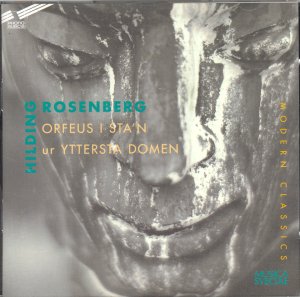Swedish
ballet music is not exactly a famous field. Alfvén's Bergakungen
(Mountain King) is an exception - a late romantic nationalist
score. This was premiered in 1923 in Stockholm. More modernistic
scores followed including the Parisian Maison de fous by
Viking Dahl. Pergament's Krelantems and Eldeling came in
1928 apparently sporting 'an unusually advanced tonal language'.
Rosenberg's full-scale ballet Yttersta domen (The
Last Judgement) dates from 1929. In the 1950s there were Blomdahl's
classical-themed Sisyfos and Minotaurus as well
as Lidholm's Riter.
The
main focus of this disc is the complete ballet score for Orpheus
in Town. But before we get to that there is the doom-laden
Prelude to the ballet The Last Judgement. This was fashioned
around Erik Axel Karlfeldt's cycle of paintings. For one reason
or another the ballet was never produced and the music became
known through an orchestral suite. The fate-heavy first section
of the prelude gives way to a quick polacca.
This
disc carries the world premiere recording of Orpheus in
Town, the complete ballet from 1938. The plot is around
the idea of Orpheus going in search of Eurydice during long summer
nights in the streets of Stockholm. It was premiered in Stockholm
on 19 November 1938.
The
grouped statues forming the fountain at the front of the opera-house
are depicted on stage. They come to life and go to a department
store for clothes to cover their nakedness. Orpheus thinks he
has found Eurydice when he chances on a performance of Gluck's
Orfeo ed Euridice at the Opera. He finds her in a dance-hall
but she will not return with him to become a statue again in the
fountain group in front of the Opera.
The
ballet had some twenty performances at the Stockholm Opera in
its original run. The Dance Suite from the nightclub dance-hall
episode of this work is the one we know from previous recordings.
This can be heard separately if you programme your player to hear
tracks 19 to 25 in sequence.
The
Dance is a very sentimental thing with a shade of the Presentation
of the Rose recurrent in the andantino at tr. 10 (Pa
Karleksudden in which the aria theme from Gluck's Orfeo
emerges in refined lovely melancholy). You can hear more from
the opera at tr. 17 and the music is tempestuously transformed
in tr. 18.
In
scene 2 (tr.4) the awakening of the statues is represented in
antique finery - with Baroque style aped and manipulated. A folk-dance
rondo comes in the shape of a tarantella (tr. 8). The Gluck
melody returns with poignant placid directness at tr. 11 - Fredrika
Bremerstatyn. Strange voices recur in this music including
the Red Indian humour of the Intermezzo II (tr. 16).
Then
we come to the Dance Suite. Rhythm of the Times (tr.
19) is part Weill, part Constant Lambert and part Ibert. The
Bartender's Dance with its wah-wah saxophone and strangulated
strings again touches on the vitriol of Weill. The Girl's Dance
is liquid jazz with a spare mix from Petrushka. The
Negress Dance is sultry and Rimskian (tr.24). The Tango
for Orpheus and The Lady is played through a Ravel-like casement
- Hispanic and close to Rapsodie Espagnole. The fun is
spoilt by the arrival of the lady's stout admirer.
Orpheus
in Town is a strange mixture. It is Gallic in the manner
of Ibert and Satie yet sentimental in the delicate manner of Ravel.
The variations wrung out of the famous aria from Orfeo ed Euridice
are one of the key pillars of the work and much is inventively
made of it. The music is a strange amalgam of the poignant, the
frivolous, the jazzy and the emotive. A stimulating and kaleidoscopically
varied work superbly presented.
Rob
Barnett
